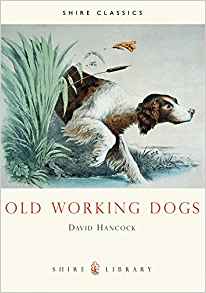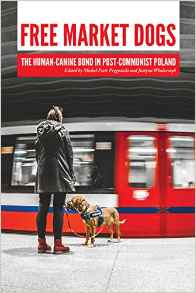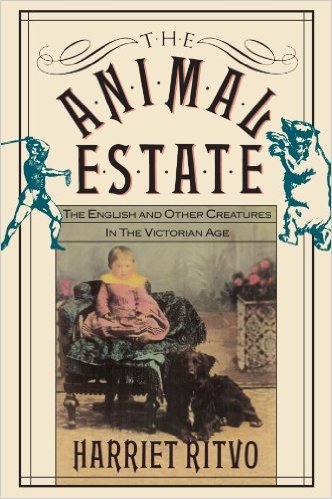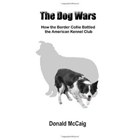Books on Animals: Dogs
Dogs in recent history and different cultures
If you want to buy a book, clicking on the book cover will take you directly to that book on the Amazon.co.uk web site.
See also:

British Dogs – Their Varieties, History, Characteristics, Breeding, Management and Exhibition
This book is a copy of a work which originally appeared in 1879. Dalziel is the main author, though he has been helped by ‘eminent fanciers’. As this mention of ‘fanciers’ implies, he’s more interested in the world of show dogs than how dogs lived and worked, so there’s a lot about the appearance of dogs, and little about anything else. This in itself tells you how much attitudes to dogs had changed during the nineteenth century.
Dalziel’s work has obvious limitations, but it is essential reading for anyone interested in how dog breeds evolved. At the start of the century, dogs were bred mainly for work, whereas by 1879, ‘breed’ was used in the same way as we use the term today, and dog shows had become dominant in defining what a breed was. People who want to return a breed to its ‘roots’ need to go further back than the late nineteenth centure to trace the origins of breeds, but Dalziel gives an interesting snapshot of breeds in development.

Old Working Dogs
David Hancock has produced some marvellous books on sporting dogs, such as terriers and gundogs. His passion comes through in his writing. His books aren’t dry texts, and they’re well-illustrated. ‘Old Working Dogs’ was first published in 1984, and is a short (32 page) account of British working dogs. Its strength is the large number of vintage photos, some of which show dogs from breeds that are now extinct. The photos are also interesting for showing how some breeds have changed over time. David Hancock is particularly interested in sporting dogs, like hounds, earth dogs, and gundogs, so these dogs have better coverage. There’s also a short section on ‘Pastoral Dogs’ with some vintage pictures. ‘Old Working Dogs’ is inexpensive, fun to read, and a good starter book on the subject.

Dogs of the Shepherds
David Hancock is better known for his books on sporting dogs, but his ‘Dogs of the Shepherds’ is interesting and enjoyable, so long as you don’t take him too seriously. There are a lot of photos, some vintage, others new, of dogs classed by kennel clubs as being of ‘pastoral’ breeds, and some photos of working sheepdogs to which it would be difficult to assign a breed.
The book covers both mastiff-type dogs, and dogs that work closely with their handlers to control the movements of livestock. There are accounts of breeds from all over the world, though most of the focus is on Europe. This broad coverage helps with understanding the different conditions these dogs have worked in, which in turn affect the different roles they have played, and the popularity of breeds that suit local conditions.
David Hancock is much stronger on sporting dogs than on pastoral dogs. This isn’t an accurate history of the development of pastoral dogs, nor does it provide an in-depth understanding of their work. If you’re really interested in, say, the history of border collies, an author who is a specialist in the breed, such as Donald McCaig on collies, would be more informative. Even so, the vintage photos in ‘Dogs of the Shepherds’ are a treat, and Hancock has a lively writing style. Even if you don’t agree with him, he’s never dull.

Cynographia britanica
Sydenham Edwards’ book originally appeared with coloured engravings, which, alas, this version lacks. There are copies of engravings, but they are in black and white, and have sometimes lost detail. Even so, it’s a delight to be able to read a work on British dogs that was begun in 1800, brought out in six instalments, the last being dated 1805.
Edwards covers Newfoundland dogs, beagles, spaniels, bull-dogs, terriers, shepherds´dogs, drovers´dogs, blood-hounds, dingoes, Pomeranians, Danish dogs, pointers and mastiffs. He covered dogs found in Britain, rather than dogs originating here. Edwards gives an account of the introduction of Spanish pointers, though he’s unsure of where Danish dogs came from. He tells us that already Danes were being bred for colour – he mentions a Harlequin Dane.
Despite the frustration of the poorly reproduced illustrations, this is an accessible insight into an early stage of the history of dog breeds.

The Dogs of the British Islands - Being a Series of Articles on the Points of their Various Breeds, and the Treatment of the Diseases to which they are Subject
Don’t be misled by the publication date of 2009, this book was first published in 1867, with later editions, so is a useful source for people interested in the history of dog breeds, rather than a guide to dogs today! ‘The Dogs of the British Isles’ is especially interesting for people researching the history of sporting dogs. Other types of dogs are covered, but people researching humbler working dogs like sheepdogs are less well served. Walsh was inaccurate when it came to breeds that he did not know well, and this applied to most toy breeds. Vets and vet nurses will find it curious to see how veterinary treatment of dogs has changed over time.
John Henry Walsh, also known as ‘Stonehenge’, was a medical doctor, who became successful as an author on hunting dogs. He was editor of The Field magazine from 1857, drawing on his own experience from keeping and training greyhounds and setters for hunting, a sport that he loved. He was also involved in the birth of the modern dog show, as a judge, and a founder member of the Kennel Club. This particular version of a classic reproduces the original illustrations in colour, and the quality of the illustrations makes the book very good value for money.

Free Market Dogs: The Human-Canine Bond in Post-Communist Poland
Free-market Dogs explores changes in the bond between dogs and humans in Poland after 1989, when Soviet rule ended, and Poland became more open to influences from outside. The seven chapters explore different themes, such as training, dogs in literature, and dog cemeteries. The first two chapters are the longest, covering changes as a whole since 1989, and changes in approaches to training.
Chapter 1, by Michal Piotr Pregowski, tells of how dogs are increasingly seen as family members in Poland, rather than as useful animals, such as guard dogs. Breeds popular as pets in the Anglo world, like Labradors and Yorkies have become more popular. There’s a desire to ‘catch up’ with Anglo countries, as well as a move towards pet rather than working dogs. It’s now considered OK to lavish special food on dogs, which shows changes in attitudes, as well as greater affluence.
Read more: Free Market Dogs: The Human-Canine Bond in Post-Communist Poland

Man and the Natural World: Changing Attitudes in England 1500-1800
Keith Thomas’s classic covers far more than dogs, it’s an interesting account of how English people saw non-human animals, plants, and ‘nature’ in general, including landscapes. There’s even an account of trees as pets! Some chapters and sections are of particular interest for dog people, for example in ‘Privileged Species’, Thomas discusses horses and dogs, noting that the way dogs were written about reflected the social status of their owners. ‘Privileged dogs’, especially hounds and lapdogs, were kept by the upper classes, and in fact from the late fourteenth century, there was a ban on ordinary people owning hunting dogs, which were reserved for those of high social status.
Read more: Man and the Natural World: Changing Attitudes in England 1500-1800

The Animal Estate: The English and other Creatures in the Victorian Age
This is a fascinating book if you’re interested in Victorian England, what Victorians thought of wild and domestic animals, and how they treated them. It’s an especially gripping story if you’re interested in the history of dogs, dog breeds, and how we got to be where we are now.
‘The Animal Estate’ is divided into three parts. Part One looks at how 'pedigree' animals became popular, both farm animals like cattle, and pets, especially dogs. If you had a pedigree dog, it was meant to show that you were different from humbler folk. The second part of the book looks at how people became interested in animal welfare, and in controlling dangerous animals, especially dogs. Legislation reflected upper class concerns about dangerous classes of human beings. Upper class folk saw brutality as characteristic of the lower classes, so cruel sports that poor people liked tended to be banned. Poor people's dogs also seemed to be more dangerous to the upper class folk who made laws. The third part of the book delves into the trend for keeping exotic animals, as pets or in zoos, and killing animals for sport in faraway places.
Read more: The Animal Estate: The English and other Creatures in the Victorian Age

The Kennel Club's Illustrated Breed Standards: The Official Guide to Registered Breeds
This is the official bible of dog breeds from the Kennel Club. Their categories of breeds: Hound, Gundog, Terrier, Utility, Working and Toy, are explained, and there's something on the history of each breed, which gives the Kennel Club explanation of why the breeds have the characteristics they do. It's useful for people who want to show dogs in the UK, as well as for groomers who prepare dogs for show, or have customers who want their dogs to look like show dogs. This is not a good guide to finding 'the right dog for you'. Not all breeds are recognised by the Kennel Club, and the emphasis is on show dogs, bred to look a certain way, rather than working or pet dogs, where working ability and temperament are important. In some breeds, such as labradors and border collies, the differences between show and working lines are so great, you could describe them as different 'breeds'.
The Kennel Club has had to answer criticisms about health issues arising from breeding for extreme shapes, for example very squashed in noses, which can lead to dogs being unable to breathe properly. Sometimes dogs bred simply to be pets can be healthier than those bred to be show dogs, if the show dogs have more exaggerated features. Inbreeding can also lead to problems. When breeds have a small gene pool, and major health problems are common, outcrossing can help to revive a breed. If you're interested in these issues, it's worth comparing what the UK Kennel Club is doing to improve the health of breeds with what's happening in Europe, especially the policies of Scandinavian and German kennel clubs.
So, this is an interesting book for people who want to know about dog show culture, but it only tells you part of the story if you want a broader picture of dog breeds.

The Dog Wars
"The Dog Wars" is the story of a battle by organizations representing owners of working Border collies to prevent the American Kennel Club (AKC) from "recognising" their breed. "Why the fuss?", you might ask. "Surely recognition from an influential body would bring benefits." Well, actually no, according to many breed organizations. For sheepdoggers, like Donald McCaig, the concern is that recognition brings pressures to breed dogs that conform to a particular appearance, the "conformation standard". Yet the essence of border collies lies in their ability to work.
The ISDS, or International Sheepdog Society, will register dogs on merit, for their ability to work, regardless of their parentage or appearance. As anyone who has watched "One Man and His Dog" knows, Border collies come in all shapes, colours, coat types and sizes. A proposal to turn this particular breed into an attractive, but useless dog, conforming to just one particular appearance template for a collie, makes no sense. Border collies are dogs bred to do a particular job. Collies bred for appearance only are therefore not border collies, regardless of their pedigrees.

A Member of the Family
A Spanish friend who knew nothing of Cesar Millan, looked at this book cover depicting Millan, wife, children and three dogs, and said 'That's immoral'. He argued that Millan should be focusing his attentions on his family, rather than wasting time on dogs. I explained that Millan has made a lot of money for his family from spending time with dogs. It was a curious criticism, which shows how strong our feelings can be when we make moral judgements about how people should behave with dogs. Millan certainly attracts a lot of moral judgements, and they say as much about where the judge is coming from as about Millan himself.
The idea that dogs should be treated as 'a member of the family' isn't accepted by everyone, and in many places dogs aren't even allowed indoors. I live in rural Spain, where people sometimes tell me that it's immoral and unnatural to keep dogs indoors. They need to be outside, so they can see and hear the world, and pee when they want to, I'm told. So the views presented in this book reflect a particular culture in which it's taken for granted that dogs should share human space, and be counted as family members. Even so, not everyone who believes that dogs can be family members approves of Millan, and their objections are often expressed with some feeling.
This book is, on the surface, a guide to living with dogs, which includes choosing a dog, raising a pup, teaching house rules, travelling with dogs, health care, and helping dogs adapt to changes, such as a new baby. Millan´s wife, Ilusión, and their children, Andre and Calvin, have a chapter each, while the last chapter deals with letting go at the end of a dog's life.
Much of the advice would be seconded by most dog trainers, though shepherds will find his description of 'The Herding Group' on p27 a little blasé. The ability of dogs to work sheep can vary within a litter, it isn't magically conferred by the AKC giving them the label 'herding'. The 'creators of these breeds' didn't 'remove the prey drive that led to a kill' (p27) in all dogs described as from 'herding' breeds. Border collies, for example, may catch and kill rabbits, and there are collies which are too rough on sheep to be safe with them.
Millan is fond of 'powerful breeds', often kept by men as symbols of their masculinity. He tends to downplay affection, which he sees as treats, playtime and physical affection. Where I live in Spain, young men with pit bulls and boxers accuse their women friends of 'treating dogs like humans', by which they mean bestowing too much affection on the dogs. Millan recognises that he grew up in a macho culture, where women were not valued. It's easy to see why some men feel very comfortable with Millan's approach, especially since pet dog trainers more often than not are women.
The most interesting chapter is perhaps 'Women and the Power of the Pack', in which Ilusión Wilson Millan explains how she had to make clear 'Rules Boundaries and Limitations' to her husband. Being selfless, working to help support his career, and raising their child, had left her ill, so she left her husband, until he agreed to go to counselling with her. She argues that women have a commitment to the pack, to the family group, which is both a strength, and a weakness. Women have to create our own boundaries in order to be strong enough to raise kids and dogs.
Leadership is important for dogs. If they ask 'what am I meant to be doing?', they need an answer. Millan´s emphasis on keeping your cool, and not taking canine 'crimes' personally is sensible. All too often we're tempted to overreact. But as Ilusión's chapter makes clear, leadership isn't a simple issue. A good leader listens, and tries to understand life from the point of view of others, while still providing direction - not an easy balancing act!
Review by Alison Lever
See also: Cesar's Rules

Cesar's Way
Cesar's Way tells the story of how Cesar Millan went to California and became famous for his work with dogs. The book also sets out what Millan believes that dogs need to have happier lives and get on better with their owners. As a child, Millan had spent time on his grandfather's farm, learning from the dogs there. They were useful dogs, helping around the farm, and were well-behaved, without formal training. In contrast, in California, Millan met well-groomed and formally trained dogs with serious behavioural problems, because their basic needs weren't being met.
Millan argues that dogs need walks, leadership from their humans, and that they benefit from the company of their own kind. He emphasises discipline. Dogs need 'rules, boundaries and limitations' in order to feel secure. Owners can confuse dogs by behaving like followers, rather than leaders, for example going to greet a dog, which is what a follower does to a leader, rather than letting the dog come to greet you, which is how a leader behaves. Some dogs may even need a 'dominance ritual', of being put on their sides, in a submissive posture. Humans should prioritise exercise, then discipline, and lastly affection, in Millan's view. The Californian owners he saw often prioritised affection, and treated their dogs like humans.
In some ways this is the story of a voyage from one culture to another, from rural Mexico to suburban and urban California. I live in rural Spain, and often hear people say that one shouldn't treat dogs like humans. There's some truth in this. Celebrating a dog's birthday may be fun, but it means more to us than to the dog. However, dressing dogs up in fancy clothes, keeping them confined, failing to help them learn social rules, and constantly gushing over them, is arguably not treating dogs like humans. If you did the same to children, it wouldn't do them much good.
It's also true that dogs need leadership, and being confident and even-tempered, like Millan´s grandfather was, is a good start. However, going up to greet a strange dog is not sensible because it may spook the dog, rather than because it means you're behaving like a follower. And, as Millan notes, putting an aggressive dog on its side could result in a bite! Lastly, though Millan puts affection bottom on his list of priorities, perhaps it needs to be redefined as meeting a dog's basic needs, rather than doing stuff, like hugging dogs, that makes us feel good.
Review by Alison Lever
See also: Cesar's Rules
Latest book reviews
Latest news and research
- Impact of facial conformation on canine health: corneal ulceration
- Prevalence of disorders recorded in dogs attending primary-care veterinary practices in England
- Disease control through fertility control: secondary benefits of animal birth control in Indian street dogs.
- Quantifying sources of environmental contamination with Toxocara spp eggs.
- Clostridium difficile in faeces from healthy dogs and dogs with diarrhea
- Impact of canine overweight and obesity on health-related quality of life
- Effect of a diet enriched with green-lipped mussel on pain behavior and functioning in dogs with clinical osteoarthritis
- Short, unstructured session with a dog reduces anxiety levels in students, and improves their mood
- Research suggests canine companionship helps calm children undergoing cancer treatment
- Dingoes in the dock
Care and behaviour of dogs
- Acknowledgments and further reading
- Aggression
- Appetite Loss
- Attention Seeking
- Barking
- Basic training
- Behavioural problems
- Behavioural problems in dogs
- Being sensible with traffic
- Bitches In Season
- Biting
- Canine Social Cognition, part 1: Dogs are special
- Canine Social Cognition, part 2: Differences between dogs
- Chasing Cars, Bikes, Joggers, Cats etc.
- Choosing a dog
- Coming when called
- Designing and using a dog garden
- Destructiveness
- Do you want your pet dog to have puppies?
- Dogs and diet
- Dogs don’t bite humans
- Dogs: Bringing up your puppy
- Dogs: Helping dogs with sound phobias, and fear of fireworks
- Fighting
- Finding a good training class
- Greeting guests politely
- Jealousy
- Jumping Up
- Learning that some animals are prey, others are not
- Mounting
- Multi-dog households: Enjoying life with more than one dog
- Phobias
- Poo Eating
- Possessiveness
- Recall
- Respecting other dogs in the household
- Respecting passers-by, human and canine
- Separation Anxiety
- Stealing
- There are acceptable and unacceptable places to perform (housetraining)
- Toilet Training
- Travelling safely in cars
- Using Flexileads safely
- Vet Phobias
- Walking nicely on the lead
- Walking On The Lead
- Wolves, Dogs and Humans














